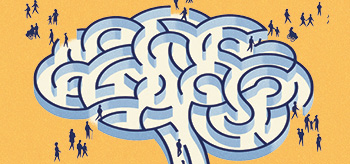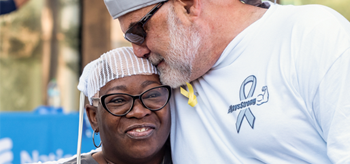Grade 1 – Pilocytic Astrocytoma
Also called Juvenile Pilocytic Astrocytoma (JPA)
Characteristics
- Slow growing, with relatively well-defined borders
- Grows in the cerebrum, optic nerve pathways, brain stem and cerebellum
- Occurs most often in children and teens
- Accounts for two percent of all brain tumors
Treatment
Surgery is the standard treatment. If the tumor cannot be completely resected, radiation or chemotherapy may be given. Chemotherapy may be given to very young children instead of radiation therapy to avoid damage to the developing brain. Some of these tumors can progress to a higher grade, so it is important to be diligent about following up with the medical team after treatment.
Please speak with your health care provider for more information about your tumor type, biomarkers, and treatment options, including clinical trials.
Grade 2 – Low-grade Astrocytoma
An astrocytoma is a type of glioma that develops from star-shaped cells (astrocytes) that support nerve cells. The WHO classifies a low-grade astrocytoma as a grade 2 tumor.
Characteristics
- Slow growing
- Rarely spreads to other parts of the CNS
- Borders not well defined
- Common among men and women in their 20s-50s
Treatment
Treatment depends on the size and location of the tumor. The doctor will most likely perform a biopsy or surgery to remove the tumor. Partial resections or inoperable tumors may be treated with radiation. Recurring tumors may require additional surgery, radiation and/or chemotherapy.
Please speak with your health care provider for more information about your tumor type, biomarkers, and treatment options, including clinical trials.
Grade 3 – Anaplastic Astrocytoma
An astrocytoma is a glioma that develops from star-shaped glial cells (astrocytes) that support nerve cells. An anaplastic astrocytoma is classified as a grade 3 tumor.
Characteristics
- Grows faster and more aggressively than grade II astrocytomas
- Tumor cells are not uniform in appearance
- Invades neighboring tissue
- Common among men and women in their 30s-50s
- More common in men than women
- Accounts for two percent of all brain tumors
Treatment
Treatment depends on the location of the tumor and how far it has progressed. Surgery and radiation therapy, with chemotherapy during or following radiation, are the standard treatments. If surgery is not an option, then the doctor may recommend radiation and/or chemotherapy. Many clinical trials using radiation, chemotherapy, or a combination are available for initial and recurrent anaplastic astrocytomas.
Please speak with your health care provider for more information about your tumor type, biomarkers, and treatment options, including clinical trials.
Grade 4 – Glioblastoma (GBM)
Glioblastoma multiforme (GBM) is the most common and deadliest of malignant primary brain tumors in adults and is one of a group of tumors referred to as gliomas.
Classified as a grade 4 (most serious) astrocytoma, GBM develops from the lineage of star-shaped glial cells, called astrocytes, that support nerve cells.
GBM develops primarily in the cerebral hemispheres but can develop in other parts of the brain, brainstem, or spinal cord.
Because of its lethalness, GBM was selected as the first brain tumor to be sequenced as part of The Cancer Genome Atlas (TCGA Website), a national effort to map the genomes of the many types of cancer. In this effort, researchers discovered that GBM has four distinct genetic subtypes that respond differently to aggressive therapies, making treatment extremely difficult and challenging. Parallel research at Johns Hopkins University also contributed to the expansion of genomic information on GBM.
Characteristics:
- Can be composed of several different cell types
- Can develop directly or evolve from lower grade astrocytoma or oligodendroglioma
- Most common in older individuals and more common in men than women
- Less common in children
- Median survival rate of eight months; 5-year survival rate of 6.8%
- The cause is unknown, but increasingly research is pointing toward genetic mutations
Incidence
The incidence, or the number of new diagnoses made annually is 2 to 3 per 100,000 people in the United States and Europe. GBM accounts for 12% to 15% of all intracranial tumors and 50% to 60% of astrocytic tumors.
Treatment
Standard treatment is surgery, followed by radiation therapy or combined radiation therapy and chemotherapy. If inoperable, then radiation or radiation/chemotherapy can be administered.
Treatment requires effective teamwork from neurosurgeons, neuro-oncologists, radiation oncologists, physician assistants, social workers, psychologists, and nurses. A supportive family environment is also helpful.
Surgery
GBM’s capacity to wildly invade and infiltrate normal surrounding brain tissue makes complete resection impossible. However, improvements in neuroimaging have helped to make better distinctions between tumor types and between tumor and normal cells.
Radiation
After surgery, radiation therapy is used to kill leftover tumor cells and try and prevent recurrence.
Chemotherapies, an Alkylating Agent, and a Medical Device
(identified by generic names)
Temozolomide
FDA-approved in 2005 for treatment of adult patients with newly diagnosed GBM
Bevacizumab
FDA-approved in 2009 for treatment of patients with recurrent GBM and prior treatment
Polifeprosan 20 with Carmustine Implant
FDA-approved in 1997 for treatment of initial occurrence GBM, an alkylating agent that is surgically implanted as a wafer after surgical resection and allows for drug delivery directly to the tumor site
TTF Device
FDA-approved in 2011 approved as a medical device for adult patients with recurrent GBM after surgery and chemotherapy treatment to deliver electric tumor-treating fields to the brain to physically break up the tumor cell membranes
Ongoing Research and Clinical Trials
Clinical Trials
The NBTS Clinical Trial Finder provides information obtained from ClinicalTrials.gov, a service of the U.S. National Institutes of Health, providing information on publicly and privately supported clinical studies of human participants with locations in all 50 States and in 196 countries.
The trials involve many types of therapy, including but not limited to immunotherapy, antiangiogenic therapy, viral therapy, and targeted therapy (personalized medicine).
Please speak with your health care provider for more information about your tumor type, biomarkers, and treatment options, including clinical trials.


